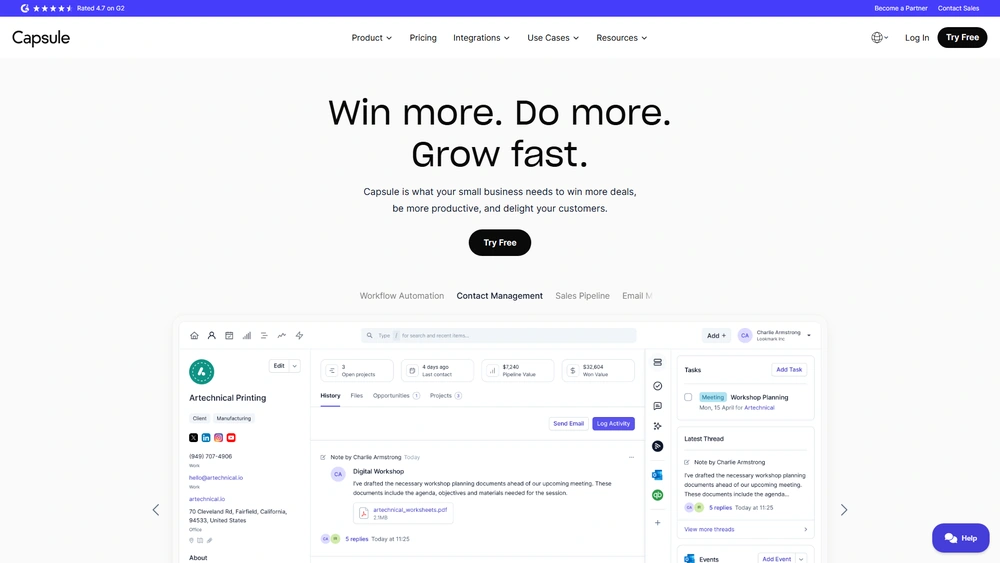Capsule and Transpond Overview & 2025 Industry Position
Capsule and Transpond has quickly gained recognition for its dual-focus architecture that combines data synchronization with intelligent workflow automation. Positioned between productivity suites and integration platforms, it bridges a critical gap for businesses that need both clean data pipelines and smart task coordination. In 2025, as companies increasingly centralize around real-time data and automated processes, Capsule and Transpond fits squarely into the pivot toward cohesive, AI-assisted ecosystems.
The platform distinguishes itself through its low-latency transponding engine, automated conditional triggers, deep API access, and a modular plugin framework supporting finance, logistics, HR, and CRM. As companies face 2025’s complexity—cross-border compliance, instant analytics, and interoperable software stacks—Capsule and Transpond scales as both a sync backbone and a workflow enabler.
From Launch to 2025: Capsule and Transpond’s Journey
Capsule and Transpond was founded in late 2018 by former engineers from Atlassian and AWS aiming to simplify how systems talk to each other securely and in real time. What began as a sync tool evolved into a robust command-center for syncing, triggering, and transforming data across platforms.
- 2019: Closed Series A after integrating with 25+ major APIs (Salesforce, Shopify, Xero)
- 2020: Released Conditional Logic Engine – allowing multi-branch triggers and transformer scripts
- 2021: Launched Transpond AI for predictive dispatch and smart routing
- 2023: ISO 27001 certified with global data region routing capabilities
- 2024: Added native modules for HRMS, logistics, and e-commerce stack orchestration
In 2025, the company is focusing on composability—allowing teams to drag-and-drop trusted prebuilt workflows or create granular data motion sequences using no-code and code-fusion templates tailored for enterprise and mid-market scale.

Capsule and Transpond Key Features
Capsule and Transpond’s dual-core framework—‘Capsule Sync’ and ‘Transpond Logic’—drives its extensibility.
- Capsule Sync: Structured, low-latency synchronization engine — perfect for multi-region data ops
- Transpond Logic: Visual and scriptable automation builder with real-time condition parsing
- AI Dispatching: Predicts task priority/route and reassigns via contextual triggers
- Modular Packs: Prebuilt for finance, HR, logistics, and Shopify/Magento operations
- Audit & Compliance: SOC2/ISO-layered activity view, with region-based actions and logs
Workflow & UX
Whether you’re a developer building data endpoints or an operations lead configuring a cross-border invoice sync, Capsule and Transpond offers a unified interface. A key UX innovation is its layered canvas:
- Layer 1: Data stream editor with schema guides
- Layer 2: Visual condition map
- Layer 3: Audit + rollback timeline
These layers can be individually toggled to avoid overload. Tooltips offer code guidance, detection prompts flag poor formatting, and dark/light modes ensure clarity for extended sessions.
Capsule and Transpond Pricing Analysis & Value Metrics
| Plan | Monthly Price | Main Features | Best For |
|---|---|---|---|
| Starter | $29 | 5 Workflows, 10,000 Tasks, Major Integrations | Startups / Simple Sync |
| Pro | $89 | 20 Workflows, API Access, 50,000 Tasks | SMBs / Modular Use |
| Enterprise | $249+ | Unlimited Workflows, On-prem Routing, AI Dispatch, SOC2-Ready | Enterprise Teams |
Value Verdict: Priced competitively below Zapier Enterprise but delivers enterprise-grade compliance and inner-network automation—especially ideal for SaaS ops, logistics, and e-commerce automation teams.
Competitive Landscape
| Platform | Best For | Key Strength | Weakness |
|---|---|---|---|
| Zapier | Simple consumer/SMB automations | Huge user base, templates | Limited dev flexibility |
| Workato | Enterprise integrations | Dev ops friendly | High cost, steeper learning |
| Capsule and Transpond | SMB + Enterprise Fusion | Dual-mode sync+logic, modular packs | Smaller ecosystem (vs Zapier) |
Top Use Cases
- D2C fulfillment pipelines (fast sync between eCom and ERP)
- Compliance routing in finance and insurance (regional regulators detection)
- Unified HR sync (BambooHR + ADP + Slack onboarding)
- IoT dispatch sync (industrial → analytics → CRM ticketing)
Capsule and Transpond Integrations
Supports over 150 platforms as of July 2025 with native priority lanes for:
- Salesforce, HubSpot, Zoho CRM
- Shopify, Magento, BigCommerce
- Xero, QuickBooks, NetSuite, Plaid
- Slack, Microsoft Teams, Zoom
- BambooHR, Workday, Gusto
Integrations benefit from a smart-layer cache so calls don’t exceed API quotas often found in high-frequency apps like QuickBooks Online.
Pros & Cons
- Pros: Fast sync engine; AI logic options; compliance-ready; PnP templates; visual canvas
- Cons: Limited mobile view editing; steep ramp for non-technical users; integrations fewer than Zapier
Final Thoughts
If your business outgrew Zapier or wants to unify fragmented workflows while retaining full control, Capsule and Transpond serves as a modular yet powerful alternative. From logistics providers syncing sensor data to fintech developers routing compliance triggers, the platform excels where sync logic meets AI-enhanced execution.
Pro Tip: Set up fallback workflows using Capsule and Transpond’s conditional branches to act if upstream data fails or exceeds quota limits—great for finance ops.
Capsule and Transpond FAQ
Yes. Enterprise plans can activate HIPAA shared instance controls and audit logs under a separate BAA agreement.
Under normal usage, sync latency is under 300ms with burst rates of up to 10k tasks per second depending on API throttle limits.
Only the Enterprise tier supports private cloud deployment options or dedicated AWS/VPC nodes.
Yes, white-labeled portals and modules are available on Pro+ plans for agencies managing multiple client workflows.
Zapier is simpler and more template-based, while Capsule and Transpond offers more control, faster sync speeds, and enterprise-grade compliance.